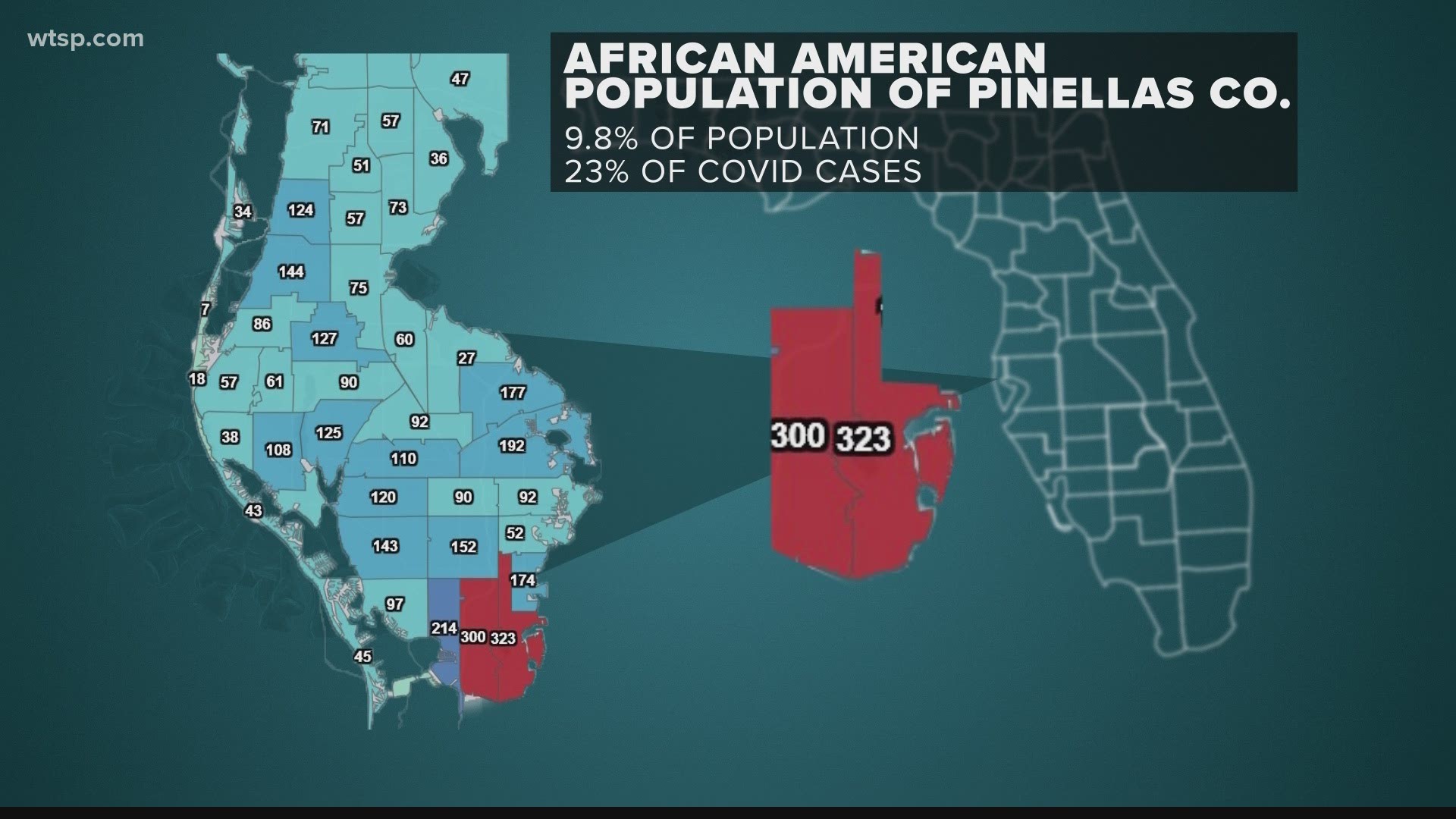ST. PETERSBURG, Fla. — When headlines nationwide started showing the disproportionate impact the coronavirus was having on the Black community, there was relief among medical and public health professionals in the Tampa Bay area because those same numbers weren’t being reflected here.
However, now that more widespread testing is available, the numbers are painting a different picture.
Of all the local counties, right now, Pinellas has the highest disparity when it comes to African Americans. This group is only about 10 percent of the population but makes up nearly a quarter of all COVID-19 cases in the county.
The two zip codes with the highest number of cases are overwhelmingly Black.
10 Tampa Bay reporter Emerald Morrow spoke with Pinellas County Commissioner Ken Welch and Dr. Kevin Sneed of the University of South Florida’s Taneja College of Pharmacy about the disparity.
NOTE: This conversation has been edited for length and clarity.
Reporter: The number of recent COVID-19 cases has broken records in Florida, and we are now starting to see glaring disparities. What has changed between now and earlier COVID outbreaks a few months back?
Dr. Kevin Sneed: The increase in COVID cases really has a lot more to do with opening this society up. We’ve had a lot more social activity. Many people probably have not worn masks as much as we probably anticipated here in the healthcare community.
And so, over the past two or three weeks, we have found that quite a few cases have probably evolved from being in places like restaurants and social gatherings…It’s rather disappointing, but now we have to address it, and we have to do a little bit more, and really hone in on the most important groups that are being affected.
Pinellas County Commissioner Ken Welch: The first discussion as we were monitoring the advance of COVID was why the disparity didn’t exist, and we surmised because we didn’t have widespread testing, particularly in the Black community. So, we focused on getting more testing out, partnering with community health centers and the department of health to get more testing out. As more testing became available, then we started to see that number go up, and it peaked at about 25 percent.
Reporter: How do we work to bring those numbers down and address the root causes of the disparities?
Ken Welch: This pandemic has opened up so many disparities that we have in this country, whether it’s access to healthcare and all the other disparities we know exist--this has kind of laid all those things bare. There’s a lot of things we need to do, whether it’s just basic access to healthcare, which the Affordable Care Act was supposed to address for us. And even in the midst of this pandemic, there’s some folks in the center who’s still trying to undermine the Affordable Care Act. So, we have to learn some lessons from this pandemic, and I think we have a good opportunity to do that.
Dr. Kevin Sneed: Over the past 40, 50, 60 years, the lack of access to health care has affected African Americans even more. Having a higher prevalence of diabetes and hypertension, and even in some cases even stress, is a big indicator for worsening conditions if you contract the coronavirus. And so, when you couple all of that together along with the fact that many African Americans may be employed in areas that are enclosed—we find that enclosed areas can be particularly troublesome.
But the leading indicator probably is a lack of access to health care. Then, social determinants of health in terms of housing, in terms of having appropriate access--and many people are in what we call food deserts. These are indicators, and once an individual is affected by the coronavirus and they have one of these other conditions, you're going to have much more deleterious effects.
Reporter: Where do we go from here?
Commissioner Ken Welch: The number one thing is maintaining access to healthcare for every American. It’s the smartest thing we can do…when folks have that early and continual access to health care, there are healthier outcomes for them and fewer expenses for the community in terms of bad health outcomes and folks using the emergency room as their primary place of health care. And so, maintaining that through the Affordable Care Act or any other means…
Emerald Morrow is a reporter with 10 Tampa Bay. Like her on Facebook and follow her on Twitter. You can also email her at emorrow@10TampaBay.com.
- Gov. DeSantis signs bill to increase teacher pay
- Pinellas County mandates face coverings inside most public buildings
- Coronavirus in Florida: State breaks another record with more than 5,000 new cases in a day
- NY, NJ and Connecticut to require travelers from COVID-19 hotspots, including Florida, to quarantine for 14 days
- Police rescue dog left in hot car in Clearwater Beach parking garage
- 'It’s not over:' MacDill reservist who spent months on COVID-19 front lines in NYC returns home with warning
- Dr. Fauci hopeful for COVID-19 vaccine by late 2020, early 2021
- New cases, hospitalizations, deaths: How Florida is doing in its COVID-19 battle
►Stay In the Know! Sign up now for the Brightside Blend Newsletter



